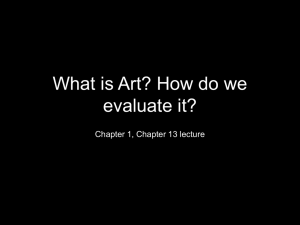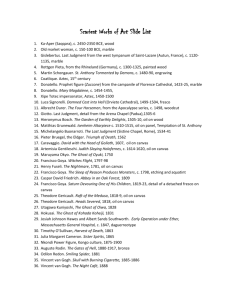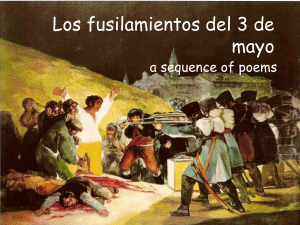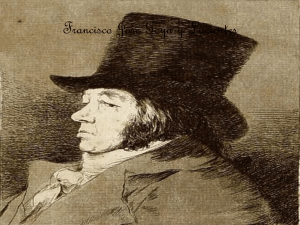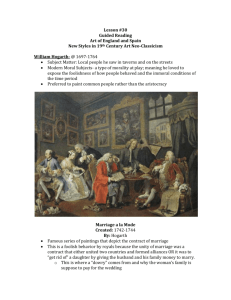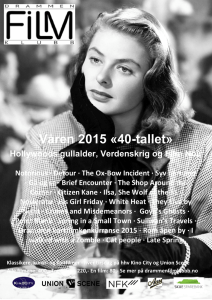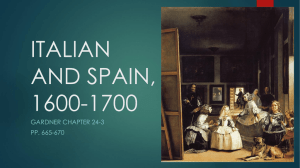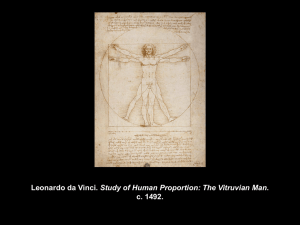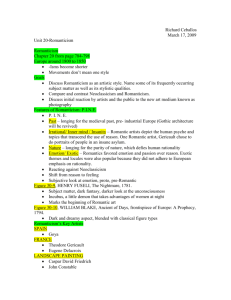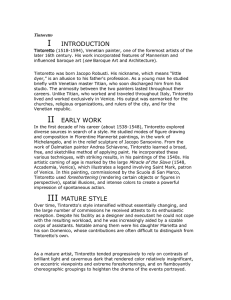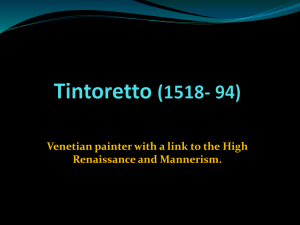A visit to the Prado Museum
advertisement
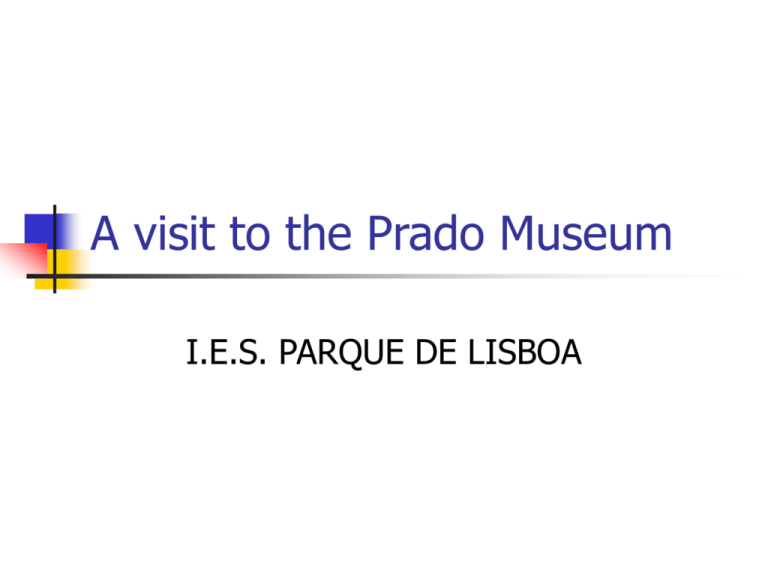
A visit to the Prado Museum I.E.S. PARQUE DE LISBOA Velázquez: “Las Meninas” Velázquez: “Las Meninas” Velázquez, Diego Rodríguez de Silva y Canvas (318 cm x 276 cm) Spanish school. 17th Century Portrait of the infanta Margarita, daughter of Felipe IV (1605-1665), surrounded by her servants. The King and Queen are reflected in the mirror at the back of the room. Complex composition: Use of perspective. It has been suggested through contrasts of light and shadow and overlapping shapes. This is the painter's most thoroughly rendered architectural space, and the only one in which a ceiling is included. Depiction of light Representation of atmosphere. The point of view of the picture is at least approximately that of the royal couple. Velázquez: “The Lances” Velázquez: “The Surrender of Breda or The Lances ” Velázquez, Diego Rodríguez de Silva y Canvas (307 cm x 367 cm) Spanish school. 17th Century The general in charge of Spanish troops in Flanders receives the keys to the city of Breda from the Dutch governor ending a long siege. 5 June 1625. Considered a key moment in the long war waged by the Spanish to prevent Dutch independence. Clear propagandistic bent. The painting takes no joy in victory, the only evidence of the battle is the smoky background. Velazquez focuses our attention of the foreground. Example of Velazquez´s mastery of all pictorial resources: skill at creating atmosphere light and landscape in his works mastery of portraiture profound knowledge of aerial perspective. Goya: “The 3rd of May 1808 in Madrid: the executions on Principe Pio hill ” Goya: “The 3rd of May 1808 in Madrid: the executions on Principe Pio hill ” Francisco de Goya y Lucientes (1746-1828) Canvas (268x347 cm). Spanish School (18th. century) Execution of patriots from Madrid by a firing squad from Napoleon’s army in reprisal for their uprising against the French occupation on the second of May, 1808. The French soldiers: right of the composition, with their backs to the viewer. They aim their rifles at the Madrilenes who are to die. The scene’s drama and tension are emphasized by the use of light, which strongly illuminates the heroes, making it possible to distinguish their characters and attitudes in a detailed psychological character study. This work may have been used to decorate a triumphal arch or to commemorate the celebrations of the second of May. Goya: “Witches' Sabbath” Goya: “Witches' Sabbath” Francisco de Goya y Lucientes (1746-1828) Wall oil painting transferred to canvas: 1,40 x 4,38 m. Spanish School (18th. century) One of the series of the fourteen Black Paintings, made on the walls of the "The Deaf Man's Villa". Located in the dining room. Interpretations are varied. Does the girl with a muff mean the initiation of a young witch, or is she just a viewer? Is the monumental figure at left the image of Capricorn, being under the influence of Saturn whose character links it with melancholy? The only clear thing is that Goya represented an alienated mass attending a particular ritual for initiated people. The composition follows these principles: the group surrounds an oval, where each of the elements is in function of the semicircle that stands out against the neuter background. Only three characters are underlined: the priest represented by the he-goat against the light, the luminous and disfigured witch and the young girl attending the ritual rather isolated. Tintoretto: “Christ Washing The Disciples' Feet” Tintoretto: “Christ Washing The Disciples' Feet” JACOPO ROBUSTI, "TINTORETTO" (1518-1594) Canvas (210x533 cms) Italian school. 16th. century Originally painted for the church of San Marcuola in Venice. Passage of the Gospel according to Saint John in which Jesus prepares to wash his disciple Simon Peter's feet. The main action, in the foreground, has been moved to one side and is balanced with a figure taking his shoes off, on the other side. Empty central space using the two groups in the foreground to frame the stage "in brackets" like. The setting is made of architectural elements. The source where Tintoretto found the inspiration for the arrangement of these classical buildings was a book by Sebastiano Serlio, an architect. Frontal conical perspective and an aerial perspective. Chromatism :the artist provides a perceptive mobility to the painting by means of an alternation between cold and warm tones. The work is lighted from three different sources: a zenithal light, a side floodlight, coming from behind the figures standing in front of Jesus, illuminates His faceand ghost-like from the cold light that covers it. El Bosco: “The Garden of Earthly Delights” El Bosco: “The Garden of Earthly Delights” HIERONYMUS VAN AEKEN BOSCH,"EL BOSCO"(14501516) Wooden Triptych (206 x 386 cm) Flemish School Gothic 15th-16th Centuries The open triptych shows three scenes. The left panel is dedicated to Paradise, while the right panel shows hell. The central panel gives its name to the entire piece, representing a garden of life’s delights or pleasures. Closed, the triptych offers a grisaille view of the third day of the creation of the World, with God the Father as Creator. This moralizing work is one of Bosch’s most enigmatic, complex and beautiful creations and was made near the end of his life.
